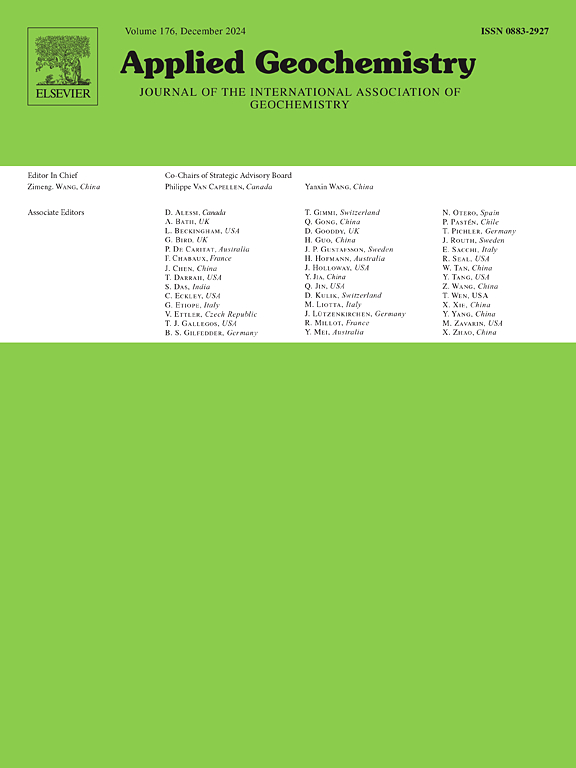解读北小安的列斯岛弧岩浆演化:来自海底岩脉主微量元素和铅同位素分析的启示
IF 3.4
3区 地球科学
Q1 GEOCHEMISTRY & GEOPHYSICS
引用次数: 0
摘要
小安的列斯弧(LAA)是一个俯冲驱动的火山系统,具有明显的地球化学和同位素变化。蒙特塞拉特岛和瓜德罗普岛是阐明北LAA地区岩浆作用的关键地点。本研究将IODP Expedition 340钻孔U1396A的海洋火山记录与陆地火山数据相结合,重建了LAA北部较长时间尺度(~ 4.5 Ma至今)的岩浆演化。通过对蒙塞拉特岛和瓜德罗普岛样品的颗粒形态、Pb同位素、全岩和熔融包裹体的主微量元素组成分析,表明其Pb同位素组成主要受岩浆源区控制,而非地壳污染。根据涉及枯竭地幔和俯冲板块成分的混合模型,瓜德罗普岛与蒙特塞拉特岛相比显示出更大的沉积物输入,这些沉积物的贡献必须作为熔体添加到瓜德罗普岛岩浆系统中,以解释其高Th/Nd比率(0.36)。虽然瓜德罗普岛和蒙特塞拉特岛之间的沉积物贡献存在显著差异,但流体输入没有明显区别。此外,瓜德罗普岛和蒙特塞拉特岛Eu和Sr特征的对比可能与斜长石聚集有关,而不是岩浆分异过程的根本差异。这项研究将小安的列斯岛弧北部的火山活动历史追溯到450万年前,填补了以前仅限于陆相火山岩研究的一个关键空白。本文章由计算机程序翻译,如有差异,请以英文原文为准。
Deciphering the magmatic evolution of the northern lesser antilles Arc: Insights from major-trace element and Pb isotopic analyses of submarine tephra
The Lesser Antilles Arc (LAA), a subduction-driven volcanic system, exhibits pronounced geochemical and isotopic variations. Montserrat and Guadeloupe serve as key locations for elucidating magmatic processes in the northern LAA region. This study integrates marine tephra records from IODP Expedition 340 borehole U1396A with terrestrial volcanic data to reconstruct the magmatic evolution of the northern LAA over an extended timescale (∼4.5 Ma to present). Through grain morphology analysis, Pb isotopes, and major/trace element compositions of whole rocks and melt inclusions, we demonstrate that the Pb isotopic compositions of samples from Montserrat and Guadeloupe are primarily controlled by magmatic source regions rather than crustal contamination. Based on mixing models involving depleted mantle and subducted slab components, Guadeloupe exhibits greater sediment input compared to Montserrat, and such sediment contributions must be added as melt additions to the Guadeloupe magmatic system to account for its elevated Th/Nd ratios (0.36). Although significant differences in sediment contributions exist between Guadeloupe and Montserrat, fluid inputs show no discernible distinction. Furthermore, the contrasting Eu and Sr signatures between Guadeloupe and Montserrat are likely attributable to plagioclase accumulation rather than fundamental differences in magmatic differentiation processes. This study extends the volcanic activity history of the northern Lesser Antilles Arc back to 4.5 million years ago, filling a critical gap in previous studies that were limited to terrestrial volcanic rocks.
求助全文
通过发布文献求助,成功后即可免费获取论文全文。
去求助
来源期刊

Applied Geochemistry
地学-地球化学与地球物理
CiteScore
6.10
自引率
8.80%
发文量
272
审稿时长
65 days
期刊介绍:
Applied Geochemistry is an international journal devoted to publication of original research papers, rapid research communications and selected review papers in geochemistry and urban geochemistry which have some practical application to an aspect of human endeavour, such as the preservation of the environment, health, waste disposal and the search for resources. Papers on applications of inorganic, organic and isotope geochemistry and geochemical processes are therefore welcome provided they meet the main criterion. Spatial and temporal monitoring case studies are only of interest to our international readership if they present new ideas of broad application.
Topics covered include: (1) Environmental geochemistry (including natural and anthropogenic aspects, and protection and remediation strategies); (2) Hydrogeochemistry (surface and groundwater); (3) Medical (urban) geochemistry; (4) The search for energy resources (in particular unconventional oil and gas or emerging metal resources); (5) Energy exploitation (in particular geothermal energy and CCS); (6) Upgrading of energy and mineral resources where there is a direct geochemical application; and (7) Waste disposal, including nuclear waste disposal.
 求助内容:
求助内容: 应助结果提醒方式:
应助结果提醒方式:


